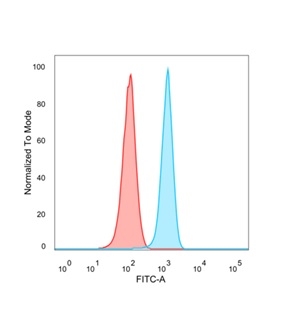Free Shipping in the U.S. for orders over $1000. Shop Now>>

Immunofluorescence Analysis of PFA-fixed HeLa cells using FOSL2 Mouse Monoclonal Antibody (PCRP-FOSL2-1B1) followed by goat anti-mouse IgG-CF488 (green). Counterstain is phalloidin.

Flow cytometric analysis of PFA-fixed HeLa cells. FOSL2 Mouse Monoclonal Antibody (PCRP-FOSL2-1B1) followed by goat anti-mouse IgG-CF488 (blue), isotype control (red).

SDS-PAGE Analysis of Purified FOSL2 Mouse Monoclonal Antibody (PCRP-FOSL2-1B1). Confirmation of Purity and Integrity of Antibody.

Analysis of Protein Array containing more than 19,000 full-length human proteins using FOSL2 Mouse Monoclonal Antibody (PCRP-FOSL2-1B1). Z- and S- Score: The Z-score represents the strength of a signal that a monoclonal antibody (MAb) (in combination with a fluorescently-tagged anti-IgG secondary antibody) produces when binding to a particular protein on the HuProtTM array. Z-scores are described in units of standard deviations (SD's) above the mean value of all signals generated on that array. If targets on HuProtTM are arranged in descending order of the Z-score, the S-score is the difference (also in units of SD's) between the Z-score. S-score therefore represents the relative target specificity of a MAb to its intended target. A MAb is considered to specific to its intended target, if the MAb has an S-score of at least 2.5. For example, if a MAb binds to protein X with a Z-score of 43 and to protein Y with a Z-score of 14, then the S-score for the binding of that MAb to protein X is equal to 29.
The Fos related gene, Fra-2, was initially molecularly cloned from chicken genomic DNA and shown to represent a new member of the immediate early gene family. The human counterpart of the chicken Fra-2 gene has since been described. Sequence alignment shows that the amino acid sequences conserved among Fra-2, c-Fos, Fra-1 and Fos B are contained in five regions. Region 2, the longest and most highly conserved region, contains the leucine zipper structure and the basic region, suggesting that like Fos, Fra-1 and Fos B, Fra-2 also forms heterodimers with c-Jun that recognize a specific DNA sequence such as the binding site for transcription factor AP-1. Such a model is further supported by the finding that the Fra-2 gene product forms a complex with c-Jun in growth-stimulated cells
There are no reviews yet.